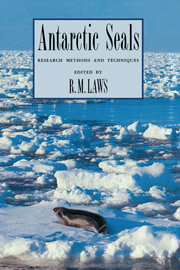Book contents
- Frontmatter
- Contents
- List of contributors
- Preface
- Introduction
- 1 Identification of species
- 2 Estimation of population sizes
- 3 Immobilization and capture
- 4 Marking techniques
- 5 Telemetry and electronic technology
- 6 Behaviour
- 7 Killing methods
- 8 Morphometrics, specimen collection and preservation
- 9 Genetic-based studies for stock separation
- 10 Collection of material for the determination of organochlorine and heavy metal levels
- 11 Age determination
- 12 Reproduction
- 13 Diet
- 14 Bioenergetics
- 15 Development of technology and research needs
- 16 Appendices
- Index
10 - Collection of material for the determination of organochlorine and heavy metal levels
Published online by Cambridge University Press: 05 February 2010
- Frontmatter
- Contents
- List of contributors
- Preface
- Introduction
- 1 Identification of species
- 2 Estimation of population sizes
- 3 Immobilization and capture
- 4 Marking techniques
- 5 Telemetry and electronic technology
- 6 Behaviour
- 7 Killing methods
- 8 Morphometrics, specimen collection and preservation
- 9 Genetic-based studies for stock separation
- 10 Collection of material for the determination of organochlorine and heavy metal levels
- 11 Age determination
- 12 Reproduction
- 13 Diet
- 14 Bioenergetics
- 15 Development of technology and research needs
- 16 Appendices
- Index
Summary
Introduction
When Antarctic seals are killed for the collection of biological material, the opportunity should be taken to collect tissues for determination of the levels of organochlorine pesticide residues (DDT and its metabolites DDE and TDE, dieldrin, hexachlorocyclohexanes, chlordane compounds, toxaphene and others), the polychlorinated biphenyls (PCBs) and heavy metals (particularly mercury and cadmium). Such contaminants may affect the conservation status of marine mammal populations (Reijnders, 1988) and may be useful for discriminating between populations (Aguilar, 1987). The material collected for these determinations and the collecting techniques are briefly outlined in this chapter. Anthropogenic hydrocarbons in the Antarctic environment have been reviewed by Hikada & Tatsukawa (1981).
General considerations
In order to establish baseline data on environmental pollutant levels in seal species, it is advisable to assess and standardize the ages and sexes of animals being taken, because environmental pollutant residues may be concentrated and metabolized differently depending on age, sex and reproductive condition of individual animals. When attempting to compare the relative concentrations of pollutants among species or subpopulations care should be taken to select tissues of animals of the same age and sex class to eliminate some of the variability.
If the animal is killed with a gun, no samples should be taken near the bullet entry or path. All tissues should be sampled from a consistent locality; Holden (1975) has suggested that the distribution of these contaminants may not be homogeneous.
Organochlorine residues
Because these contaminants tend to accumulate in tissues with a high lipid content, the highest levels are found in blubber, and this is a preferred material for collection.
- Type
- Chapter
- Information
- Antarctic SealsResearch Methods and Techniques, pp. 194 - 198Publisher: Cambridge University PressPrint publication year: 1993



